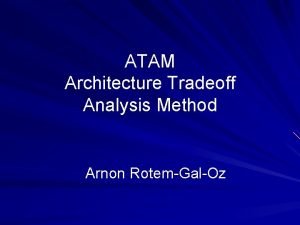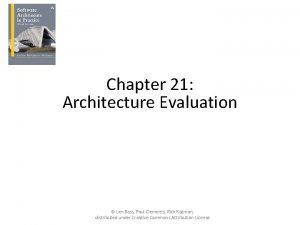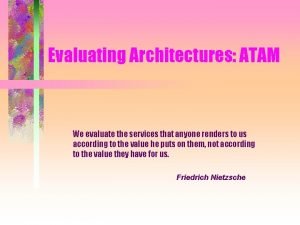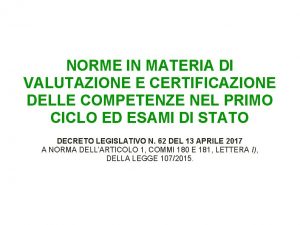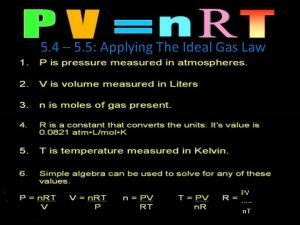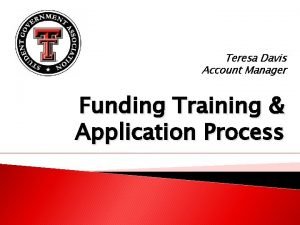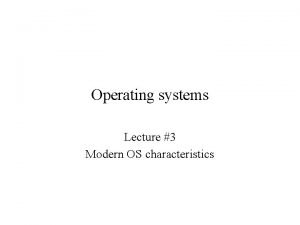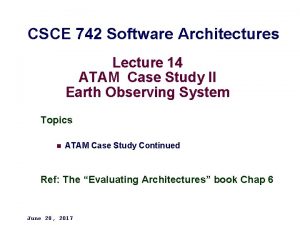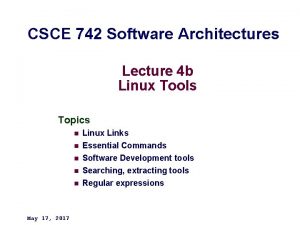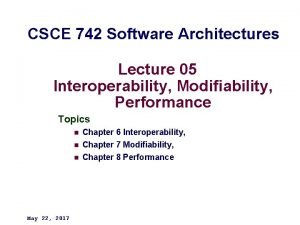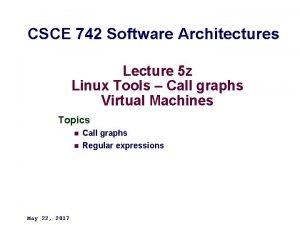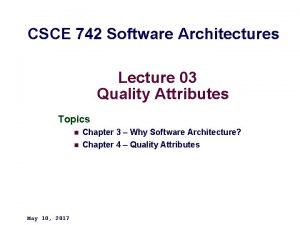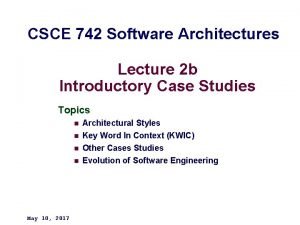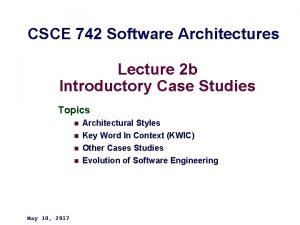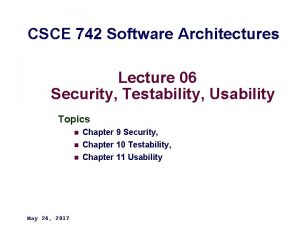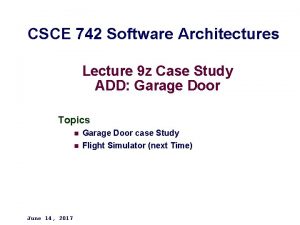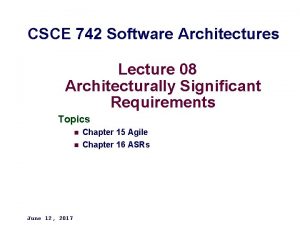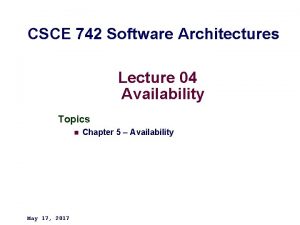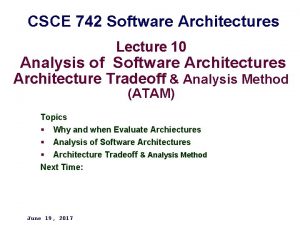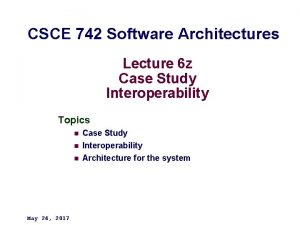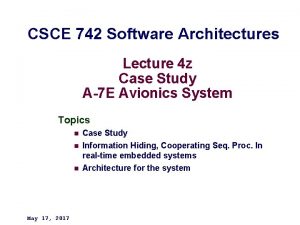CSCE 742 Software Architecture Lecture 17 ATAM Team
















- Slides: 16

CSCE 742 Software Architecture Lecture 17 ATAM Team Expertise Topics n n ATAM – team expertise and experience needed Chapter 24 Next Time: July 10, 2017

Chapter 24 Outline Competence of Individuals: Duties, Skills, and Knowledge of Architects Competence of a Software Architecture Organization Summary – 2– © Len Bass, Paul Clements, Rick Kazman, distributed under CSCE 742 Summer 2017 Creative Commons Attribution License

Competence of Individuals Duties Skills – 3– Knowledge © Len Bass, Paul Clements, Rick Kazman, distributed under CSCE 742 Summer 2017 Creative Commons Attribution License

Technical Duties of an Architect General Duty Specific Duties Creating an architecture Evaluating and analyzing an architecture Architecting Documenting an architecture Working with and transforming other systems Performing other architecting duties Managing the requirements Implementing the product Other life cycle activities Testing the product Evaluation future technologies – 4– © Len Bass, Paul Clements, Rick Kazman, distributed under Selecting tools and technology CSCE 742 Summer 2017 Creative Commons Attribution License

Non-Technical Duties of an Architect General Duty Specific Duties Managing the project Management Organization and business related duties Leadership and team building – 5– Managing the people Supporting the management Supporting the organization Supporting the business Providing technical leadership Building a team © Len Bass, Paul Clements, Rick Kazman, distributed under CSCE 742 Summer 2017 Creative Commons Attribution License

Skills of an Architect General Skill Area Communication skills Interpersonal skills Specific Skills Outward Inward Within team With other people Leadership Workload management Work skills Skills to excel in corporate environment Skills for handling information Skills for handling unexpected – 6– © Len Bass, Paul Clements, Rick Kazman, distributed under CSCE 742 Summer 2017 Creative Commons Attribution License

Knowledge of an Architect General Knowledge Area Specific Knowledge Architecture Computer Science knowledge Software Engineering Design knowledge Programming knowledge Technology and Platforms Specific knowledge General knowledge Domain knowledge Industry knowledge Organization context and Enterprise knowledge management © Len Bass, Paul Clements, Rick Kazman, distributed under – 7– CSCE 742 Summer 2017 Leadership and management Creative Commons Attribution License

Organizational Competence It is not enough for the architect to be competent The organizational setting is usually outside the control of individual architects. The architect must operate in an environment that understands how to create/nurture/reward architects. – 8– © Len Bass, Paul Clements, Rick Kazman, distributed under CSCE 742 Summer 2017 Creative Commons Attribution License

Some Examples of Activities by a Competent Organization Establish a career track for architects. Establish a clear statement of responsibilities and authority for architects. Establish a mentoring program for architects. Establish an architecture training/education program. Include architecture milestones in project plans. Have architects provide input into product definition. Have architects advise on development team structure. Give architects influence throughout the entire project life cycle. Reward or Bass, penalize architects based on project © Len Paul Clements, Rick Kazman, distributed under – 9– CSCE 742 Summer 2017 Creativeor Commons Attribution License success failure.

Assessing an Organization There are three practice areas that can be used to assess an organization's competence. n n n – 10 – Software Engineering Technical Management Organizational Management © Len Bass, Paul Clements, Rick Kazman, distributed under CSCE 742 Summer 2017 Creative Commons Attribution License

Software Engineering Organizations should have defined practices for Quality Attribute Elicitation Tools and Technology Selection Modeling and Prototyping Architecture Design Architecture Description Architecture Evaluation System Implementation Software Design (design conforms to architecture) Software Coding (code conforms to design and architecture) Software Verification Proving Properties of the Software Testing – 11 – © Len Bass, Paul Clements, Rick Kazman, distributed under CSCE 742 Summer 2017 Creative Commons Attribution License

Technical Management Organizations should have defined practices for Business or Mission Goals Setting goals Setting functional requirements Allocating Resources Setting architect’s workload and schedule Funding stakeholder involvement Project plan structure aligned with architecture structure. Adequate time planned for architecture evaluation. Establish organization-wide architecture practices Process monitoring and improvement Reuse Collaboration with manager – 12 – © Len Bass, Paul Clements, Rick Kazman, distributed under CSCE 742 Summer 2017 Creative Commons Attribution License

Organizational Management Organizations should have defined practices for Career track for Architects Leadership roles for architects Succession planning Ongoing training Creating and sustaining an internal community of architects Supporting participation in external communities Organizational Planning Technology Planning and Forecasting – 13 – © Len Bass, Paul Clements, Rick Kazman, distributed under CSCE 742 Summer 2017 Creative Commons Attribution License

Questions within Competence Categories Within each competence category one can have questions to evaluate how well an organization measures against particular criteria. E. g. n How do you ensure that the architecture is aligned with the business goals? n What is the input into the architecture creation process? What inputs are provided to the architect? n How does the architect validate the information provided? What does the architect do in case the input is insufficient or inadequate? – 14 – © Len Bass, Paul Clements, Rick Kazman, distributed under CSCE 742 Summer 2017 Creative Commons Attribution License

Assessment in Practice Based on these kinds of questions, skilled evaluators can assess the organization’s competence The output is a list of strengths and weaknesses. The weaknesses can lead to an improvement plan. – 15 – © Len Bass, Paul Clements, Rick Kazman, distributed under CSCE 742 Summer 2017 Creative Commons Attribution License

Summary Individuals need to have particular knowledge and skills as architects. These lead to duties. Organizations need to provide an environment that supports architects, creates new architects, and evaluates and rewards successful architects. All of this can be evaluated, to help guide an organization to improve its organizational competence. – 16 – © Len Bass, Paul Clements, Rick Kazman, distributed under CSCE 742 Summer 2017 Creative Commons Attribution License
 Atam steps
Atam steps Atam architecture evaluation method
Atam architecture evaluation method Atam architecture evaluation method
Atam architecture evaluation method Menu atam
Menu atam D.m. 742 del 2017 slide
D.m. 742 del 2017 slide Calculate the density of xenon gas at a pressure of 742
Calculate the density of xenon gas at a pressure of 742 Sga-742
Sga-742 Chmod 742
Chmod 742 420 in word form
420 in word form 142 984 km in miles
142 984 km in miles 01:640:244 lecture notes - lecture 15: plat, idah, farad
01:640:244 lecture notes - lecture 15: plat, idah, farad Architecture business cycle
Architecture business cycle Return architecture
Return architecture Computer architecture notes
Computer architecture notes Computer architecture lecture
Computer architecture lecture Bureaucratic bypass syndrome
Bureaucratic bypass syndrome Team spirit becomes team infatuation
Team spirit becomes team infatuation
